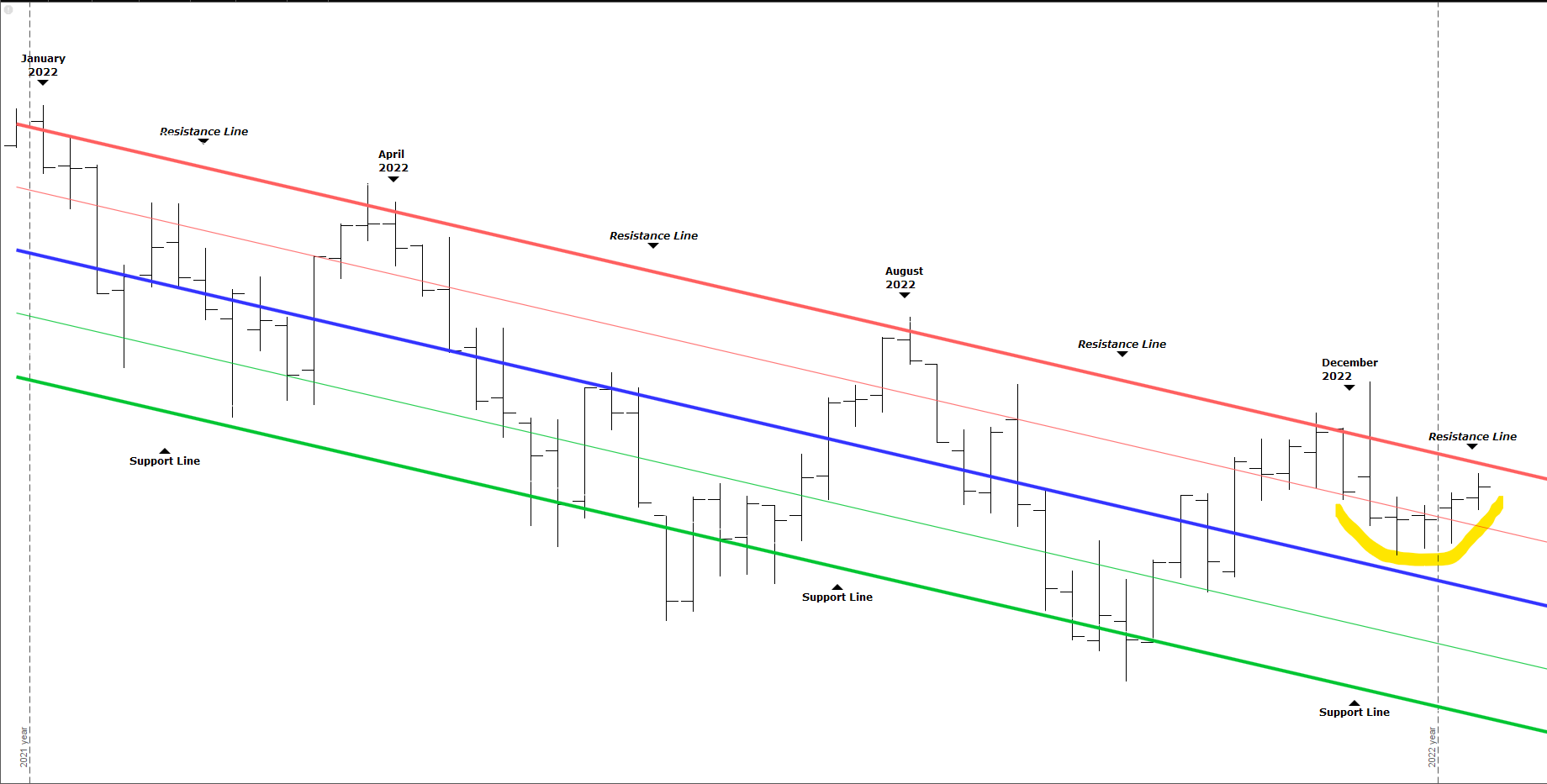Freedom Capital Management February Market Update (Click for Full Article)
February 13, 2023
In last month’s newsletter, I mentioned this is the first time in over a year that the market has turned up and not broken the blue mid-line to the downside. The yellow line shows the upturn and now we have also broken above the red resistance line. Market momentum may be changing. It would be encouraging if the market can stay above the red line and continue to strengthen. Can resistance become support? That is the question.
On February 1st, Federal Open Market Committee boosted the federal funds rate by another 0.25 percentage point. The move marked the eighth increase since March 2022. That takes it to a target range of 4.5%-4.75%, the highest since October 2007. The Federal Reserve is still trying to bring down inflation and gave little indication that they are nearing the end of this hiking cycle, despite recent signs of slowing. At least this latest rate hike was only 0.25 percent. Also, this week the Bureau of Labor Statistics will report on the Consumer Price Index (CPI) for Year over Year, Month to Month, and the Core CPI report. Once again, these reports usually have an impact on the markets, especially when dealing with the inflationary environment we are in. I am interested in the market reaction and direction.
The VIX Index on Friday closed at 20.53. On January 3rd it was at 22.90. The VIX hit a recent high of 29.11 on November 21. A falling VIX is generally bullish for the markets.
Percent of stocks above their 50-day and 200-day moving average: On January 3rd, 46% of stocks were above their 50-day moving average, today 72% are above their 50-day moving average. Last month 47% of the stocks were above their 200-day moving average, today 70% are above their 200-day moving average. These numbers have increased supporting the recent upside momentum.
Federal Reserve: The next Federal Reserve announce will be March 22nd. The CME FedWatch Tool is predicting a 90% chance the Federal Reserve will raise interest rates another .25 basis points.
Employment Rate: Total nonfarm payroll employment rose by 517,000 in January, and the unemployment rate changed little at 3.4 percent, the U.S. Bureau of Labor Statistics reported February 3rd.. Job growth was widespread, led by gains in leisure and hospitality, professional and business services, and health care. Employment also increased in government, partially reflecting the return of workers from a strike.
Inflation Rate: The annual inflation rate for the United States is 6.5% for the 12 months ended December 2022 after rising 7.1% previously, according to U.S. Labor Department data published Jan. 12. The next inflation update is scheduled for release on Feb. 14, 2023, at 8:30 a.m. ET. It will offer the rate of inflation over the 12 months ended January 2023.
The 10-year Treasury index yield: The rate today is at 3.71%. On January 3rd it was it closed at 3.79%. The intra-day high so far for this year was on January 3rd at 3.79%.
To view past Market Newsletters, go to www.freedomcapitalmanagement.com. On the home page are recent newsletters, for older newsletters go to the blog page tab at the top of the home page.
In this month’s recap: Investors were in a buying mood thanks to moderating inflation, a better-than-feared earnings season, and healthy economic data.
Monthly Economic Update
Presented by Guy Woolley, February 2023
U.S. Markets
Stocks rallied in January as moderating inflation, a better-than-feared earnings season, and healthy economic data put investors in a buying mood.
For the month, the Dow Jones Industrial Average rose by 2.83 percent, the Standard & Poor’s 500 Index jumped by 6.18 percent, and the Nasdaq Composite vaulted by 10.68 percent.1
Shift in Sentiment
The stock market opened the new year the way it ended the previous year, moving lower with high-growth names bearing the brunt of selling. Particularly troublesome to investors was the continued strength of the labor market, which heightened worries that the Fed would hike rates higher for longer to bring inflation to its target rate of 2.0 percent.
But market sentiment took a sharp U-turn after another cooling consumer inflation number reinforced the disinflationary trend of the last six months. Suddenly, investors appeared to adopt a different view of the future–one characterized by continued disinflation, a rate hike cycle nearing its end, and a fading probability of a near-term recession.2
The Power of Earnings
Corporate earnings provide some much-needed support for the rally. Investors were looking for insights to gauge the state of the U.S. economy through corporate reports and the guidance that management was offering on forward earnings prospects.
As of January 27th, with 29 percent of the companies comprising the S&P 500 Index reporting, 69 percent reported earnings above Wall Street estimates, less than the five-year average of 77 percent but strong enough to bolster confidence.3
A Winding Road Higher
The march toward higher stock prices did not follow a straight line. The month’s trading was choppy, with stretches that saw the resurfacing of recession fears and anxieties over future Fed rate hikes. For instance, stocks retreated midmonth on weak retail sales and manufacturing data that raised concerns that the Fed might have gone too far in raising rates.
As the month ended, stocks wavered ahead of a busy week for earnings and the scheduled Fed meeting. But they regained their footing on the final day of trading to close out a strong month.
Sector Scorecard
Most industry sectors ended higher in January, including Communications Services (+14.77 percent), Consumer Discretionary (+15.13 percent), Energy (+2.81 percent), Financials (+6.81 percent), Industrials (+3.71 percent), Materials (+8.97 percent), Real Estate (+9.91 percent), and Technology (+9.26 percent). Three sectors posted losses: Consumer Staples (-1.09 percent), Health Care (-1.83 percent), and Utilities (-2.00 percent).4
What Investors May Be Talking About in February
In the month ahead, investors are expected to dig into the details of the January inflation report scheduled for release on February 14.5
Investors cheered when the December update showed that inflation dropped again, confirming a six-month downtrend.
While the cost of goods has dropped over that time, the cost of services has stubbornly remained high.
In gauging how the Fed is viewing inflation progress, investors may keep an eye on the labor market, a major contributor to service costs. The Fed has expressed that a tight labor market, with its attendant wage gains, places upward pressure on inflation.
Consequently, wage trend reports, including the monthly Employment Situation Summary and the Atlanta Fed’s monthly Wage Growth Tracker, along with the services inflation number, may become the real headlines going forward.
T I P O F T H E M O N T H
If you’re financing a new car, look for the best interest rate before setting foot in the dealership. It could be to your advantage to take a cash rebate and get a loan elsewhere.
World Markets
The MSCI EAFE Index gained 8.05 percent, sparked by falling inflation, an improving economic outlook in Europe, and the continued reopening of China.6
European markets saw solid gains, led by Italy, which picked up 12.04 percent. France tacked on 9.40 percent, Germany rose by 8.65 percent, and the U.K. advanced by 4.29 percent.7
On the Pacific Rim, China’s Hang Seng Index rose by 11.57 percent, and Australia’s ASX 200 climbed by 6.22 percent. Closest to the U.S., Mexico’s IPC All-Share rallied 12.59 percent.8
Indicators
Gross Domestic Product: The nation’s economy grew at a 2.9 percent annualized rate in the fourth quarter. This represented a slowdown from the 3.2 percent expansion in the third quarter, though it is a tick higher than the 2.8 percent consensus estimate by economists.9
Employment: Employers added 223,000 jobs in December, while wage growth slowed to a 0.3 percent gain from the previous month and 4.6 percent from a year ago. The unemployment rate fell to 3.5 percent.10
Retail Sales: Retail sales fell by 1.1 percent in December, while November sales were revised downward. It was the second consecutive month of month-over-month declines and the largest contraction in a year.11
Industrial Production: Industrial production declined by 0.7 percent, led by a 1.3 percent decline in manufacturing output. Output by the nation’s factories, mines, and utilities fell by 1.7 percent on an annualized basis in the fourth quarter.12
Housing: Housing starts dropped by 1.4 percent in December, though single-family housing starts rebounded by 11.3 percent.13
Sales of existing homes fell for the 11th consecutive month, slipping by 1.5 percent in December. For the full year of 2022, sales declined by 17.8 percent–the weakest annual result since 2014.14
New home sales rose by 2.3 percent, making it the third consecutive month of increases, though 2022 sales fell to their lowest level in four years.15
Consumer Price Index: The rise in consumer prices slowed for the sixth month straight, falling by 0.1 percent month over month and decelerating to a 6.5 percent increase from a year ago. Core prices (excluding energy and food) rose by 5.7 percent, an easing from November’s 6.0 percent year-over-year jump.16
Durable Goods Orders: Orders for long-lasting goods rose by 5.6 percent in December–well above the 2.4 percent forecast.17
Q U O T E O F T H E M O N T H
“Don’t try to solve serious matters in the middle of the night.”
PHILIP K. DICK
The Fed
Minutes from December’s meeting of the Federal Open Market Committee (FOMC) reflected concerns that investors’ hopes of near-term easing in short-term rate hikes could make the Fed’s job of combating inflation more difficult.18
These minutes also indicated that additional rate hikes are likely, at least through the spring, with any potential cuts not expected to occur until sometime in 2024.
Fed officials welcomed the recent cooling in monthly inflation numbers but would require more sustained progress before they felt confident that inflation was under control.18
Sources: Yahoo Finance, January 31, 2023.
The market indexes discussed are unmanaged and generally considered representative of their respective markets. Individuals cannot directly invest in unmanaged indexes. Past performance does not guarantee future results. U.S. Treasury Notes are guaranteed by the federal government as to the timely payment of principal and interest. However, if you sell a Treasury Note prior to maturity, it may be worth more or less than the original price paid.
T H E M O N T H L Y R I D D L E
What can you fill with empty hands?
LAST MONTH’S RIDDLE: I am the center of gravity, and part of every victory. I am clearly seen in the middle of a river. Three are in love with me and I have three associates in vice. What am I?
ANSWER: The letter V.
Guy Woolley may be reached at 415.236-5364
www.freedomcapitalmanagement.com
Know someone who could use information like this?
Please feel free to send us their contact information via phone or email. (Don’t worry – we’ll request their permission before adding them to our mailing list.)
«RepresentativeEmailDisclosure»
This material was prepared by MarketingPro, Inc., and does not necessarily represent the views of the presenting party, nor their affiliates. The information herein has been derived from sources believed to be accurate. Please note – investing involves risk, and past performance is no guarantee of future results. Investments will fluctuate and when redeemed may be worth more or less than when originally invested. This information should not be construed as investment, tax or legal advice and may not be relied on for the purpose of avoiding any Federal tax penalty. This is neither a solicitation nor recommendation to purchase or sell any investment or insurance product or service, and should not be relied upon as such. All market indices discussed are unmanaged and are not illustrative of any particular investment. Indices do not incur management fees, costs, or expenses. Investors cannot invest directly in indices. All economic and performance data is historical and not indicative of future results. The Dow Jones Industrial Average is a price-weighted index of 30 actively traded blue-chip stocks. The NASDAQ Composite Index is a market-weighted index of all over-the-counter common stocks traded on the National Association of Securities Dealers Automated Quotation System. The Standard & Poor’s 500 (S&P 500) is a market-cap weighted index composed of the common stocks of 500 leading companies in leading industries of the U.S. economy. The Russell 2000 Index measures the performance of the small-cap segment of the U.S. equity universe. The CBOE Volatility Index® (VIX®) is a key measure of market expectations of near-term volatility conveyed by S&P 500 stock index option prices. NYSE Group, Inc. (NYSE:NYX) operates two securities exchanges: the New York Stock Exchange (the “NYSE”) and NYSE Arca (formerly known as the Archipelago Exchange, or ArcaEx®, and the Pacific Exchange). NYSE Group is a leading provider of securities listing, trading and market data products and services. The New York Mercantile Exchange, Inc. (NYMEX) is the world’s largest physical commodity futures exchange and the preeminent trading forum for energy and precious metals, with trading conducted through two divisions – the NYMEX Division, home to the energy, platinum, and palladium markets, and the COMEX Division, on which all other metals trade. The SSE Composite Index is an index of all stocks (A shares and B shares) that are traded at the Shanghai Stock Exchange. The CAC-40 Index is a narrow-based, modified capitalization-weighted index of 40 companies listed on the Paris Bourse. The FTSEurofirst 300 Index comprises the 300 largest companies ranked by market capitalization in the FTSE Developed Europe Index. The FTSE 100 Index is a share index of the 100 companies listed on the London Stock Exchange with the highest market capitalization. Established in January 1980, the All Ordinaries is the oldest index of shares in Australia. It is made up of the share prices for 500 of the largest companies listed on the Australian Securities Exchange. The S&P/TSX Composite Index is an index of the stock (equity) prices of the largest companies on the Toronto Stock Exchange (TSX) as measured by market capitalization. The Hang Seng Index is a free float-adjusted market capitalization-weighted stock market index that is the main indicator of the overall market performance in Hong Kong. The FTSE TWSE Taiwan 50 Index is a capitalization-weighted index of stocks comprising 50 companies listed on the Taiwan Stock Exchange developed by Taiwan Stock Exchange in collaboration with FTSE. The MSCI World Index is a free-float weighted equity index that includes developed world markets and does not include emerging markets. The Mexican Stock Exchange, commonly known as Mexican Bolsa, Mexbol, or BMV, is the only stock exchange in Mexico. The U.S. Dollar Index measures the performance of the U.S. dollar against a basket of six currencies. Additional risks are associated with international investing, such as currency fluctuations, political and economic instability, and differences in accounting standards. This material represents an assessment of the market environment at a specific point in time and is not intended to be a forecast of future events or a guarantee of future results. MarketingPro, Inc. is not affiliated with any person or firm that may be providing this information to you. The publisher is not engaged in rendering legal, accounting, or other professional services. If assistance is needed, the reader is advised to engage the services of a competent professional.
CITATIONS:
- WSJ.com, January 31, 2023
- CNBC.com, January 12, 2023
- Insight.FactSet.com, January 27, 2023
- SectorSPDR.com, January 31, 2023
- BLS.gov, January 31, 2023
- MSCI.com, January 31, 2023
- MSCI.com, January 31, 2023
- MSCI.com, January 31, 2023
- CNBC.com, January 26, 2023
- WSJ.com, January 6, 2023
- WSJ.com, January 18, 2023
- FederalReserve.gov, January 18, 2023
- Reuters.com, January 19, 2023
- WSJ.com, January 20, 2023
- Bloomberg.com, January 26, 2023
- WSJ.com, January 12, 2023
- CNBC.com, January 26, 2023
- WSJ.com, January 4, 2023



